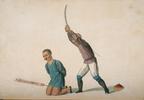|

Copyright: Turandot |
ID: 337
Ressource_Provider: Jérôme Bourgon
Title: Decapitation
DocumentNature: Watercolor
Repository: Turandot
Color: Color
Topic: Decapitation 斬刑
Description: THE MANNER OF BEHEADING.
This sort of punishment, being deemed in the highest degree ignominious, is only inflicted for crimes, which are regarded by the Chinese government, as the most prejudicial to society; such as conspiracy, assassination, committing any offence against the person of the Emperor, or attempting the life of any of the imperial family; revolting, insurrection, striking a parent, or any other unnatural sort of crime. The malefactor, who is condemned to be beheaded, is made to kneel upon the ground, the board of infamy is taken from his back, and the executioner, by a single blow of a two-handed sword, strikes off his head with great dexterity. These headsmen, and indeed, the generality of inferior officers of justice in China, are selected from the soldiery, according to the custom of primitive barbarians; neither is this employment considered more ignominious, than the post of principal officer of executive justice in other countries. Decapitation is held, by the Chinese, as the most disgraceful kind of death; because the head, which is the principal part of a man, is separated from the body, and that body is not consigned to the grave as entire as lie received it from his parents. If a great mandarin be convicted of any atrocious offence, he is executed in this manner like the meanest person. After the head is severed, it is frequently suspended from a tree, by the side of a public road; the body is thrown into a ditch, the law having deemed it unworthy the respect of regular funereal rites.
When a sentence is submitted to the Emperor for his approbation, if the crime be of the first degree of atrocity, he orders the malefactor to be executed without delay; when it is only of an ordinary nature, he directs, that the criminal shall be imprisoned until the autumn, and then executed; a particular day of that season being allotted for such ceremonies.
The Emperor of China seldom orders a subject to be executed, until he has consulted with his first law officers, whether he can avoid it, without infringing on the constitution of his realm. He fasts for a certain period, previous to signing an order for an execution; and his imperial majesty esteems those years of his reign the most illustrious and most fortunate, in which he has had the least occasion to let fall upon his subjects the rigorous sword of Justice.
----------------------------------------------------------
MANIÈRE DE COUPER LA TÊTE, OU DECAPITER.
Cette peine passe pour le plus ignominieuse. On ne l'inflige que pour des crimes, que le gouvernement Chinois regarde comme les plus préjudiciables à la société ; telles que les conspirations, l'assassinat, les offenses contre la personne de l'Empereur, attenter à la vie des personnes de la famille impériale, la revolte, l'insurrection, frapper son père ou sa mère, et toute autre espèce de crimes, contraires à la nature.
Le malfaiteur, condamné à être décapité, est à genoux par terre; on lui retire la planche qu'il a sur le dos, et l'exécuteur, d'un seul coup d'un large cimeterre, lui coupe la tête, avec beaucoup de dextérité. Ces exécuteurs, et la plus part des officiers inférieurs de justice, en Chine, sont choisi parmi les soldats, selon l'usage des anciens barbares. On ne croit pas leur emploi plus ignominieux que la place du principal officier de la justice executive dans un autre pats.
Avoir la tête coupée, c'est parmi les Chinois la mort la plus infâme, parce que la tête, qui fait la partie principale de l'homme, est séparée du corps; et l'on ne donne pas la sépulture à ce corps, parce qu'il n'est pas entier, comme on l'avoit reçu de la nature. Un mandarin, convaincu d'un crime atrôce, est exécuté de la même manière que les personnes de la plus basse condition. Après que la tête est séparée, on la suspend fréquemment à un arbre sur une route publique, et on jette le corps dans un fosse; la loi le juge indigne du respect des cérémonies ordinaires des funerailles.
Lorsque la sentence est soumise à l'Empereur, pour obtenir son approbation, si le crime est du premier dégré d'atrocité, l'Empereur fait exécuter le malfaiteur sans delay; aile crime n'a point ce dégré d'atrocité, il ordonne que le criminel soit emprisonné jusqu'à l'automne, pour Être exécuté le jour, qui est fixé dans cette saison pour ces exécutions.
L'Empereur de la Chine fait rarement exécuter un de ses sujets, sans avoir consulté les premiers officiers de justice, pour savoir s'il peut l'éviter, sans enfreindre, ou mettre en danger, la constitution de son royaume. Avant designer l'ordre de l'exécution, il jeune un certain temps; il regarde comme les années les plus illustres, et les plus fortunées de son règne, celles où il a eu le moins d'occasions de faire tomber sur ses sujets le glaive rigoureux de la justice.
Keyword: decapitation, beheading
Bibliography
1:Name:
MASON, George Henry, Pu-qùa (ill.), DADLEY (grav.) The Punishments of China, Illustrated by Twenty-two Engravings with Explanations in English and French
Related Replication (1)
1 Ressource_Provider: Jérôme Bourgon
Title: Kneeling for beheading
Information: A standard view in watercolor albums, with many variations
Related VisualSet (1)
1 Title: The Punishments of China, Illustrated by Twenty-two Engravings with Explanations in English and French
DocumentNature: Engraving
Derniére modification le : 2006-12-12 |
